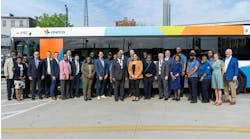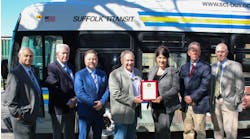With the many questions about changes in federal funding with MAP-21, Federal Transit Administrator Peter Rogoff requested to have a special informal session where he could address many of those concerns and lead a discussion about safety initiatives at the recent American Public Transportation Association’s Bus and Paratransit Conference.
The idea to have this session came to him when testifying recently and there was a lot of anxiety and concerns raised. He thought it would make sense to have a dialogue because, he said, “It’s important for people to understand what we’re doing and what we aren’t doing.”
He reiterated that the safety initiative is meant to add value with adding a lot of cost or bureaucracy. And acknowledged that at the FTA, that has not always been the case.
While the sequester hit hard, including the FTA, the base budget had been adjusted upward so the FTA could avoid furloughs this year. The administration budget is greatly constrained and one area that was greatly pulled back was the travel budget, but they are still looking to do maximum outreach however possible, including expanding their use of social media and more video conferencing. “It’s sub-optimal. But if that’s the only way we can communicate this year, it’s better than nothing at all.”
Safe Transit
“We run an extraordinarily safe industry,” Rogoff said. There are challenges to add value without adding cost and he stated there will undoubtedly be some growing pains.
In 2009, President Obama submitted safety measures to Congress, primarily on rail transit because there was a loophole in the law relating to transit that there not federal safety oversight but 27 separate safety oversight agencies. Rogoff said it was oftentimes a paper exercise with a governor appointing someone with that oversight.
After the crash in 2009, Secretary LaHood and the department looked at the issue and while accidents are very much the exception, they were looking for expanded safety authority and MAP-21 included that, though not identical to what was proposed. Some was identical, however there were some significant changes.
Rogoff said as we face challenges of aging infrastructure, growing retirements of skilled professionals, financial stresses, and rising healthcare costs and pension costs, these initiatives will help to sustain a very safe industry.
Safety Management Systems
A safety management system is the process of continuing improvement and utilizing maximum information to make the smartest decisions to enhance safety at the local level. “It’s not a one size fits all to transit safety,” Rogoff said. Even similar systems may have very different safety challenges and everyone is already doing this to some extent.
One question that has been brought up is the regulatory requirement on certification for safety professionals in the industry and Rogoff said we need to boost the core of our numbers of individuals now as he doesn’t want it to turn into something where agencies are hiring these people away from each other.
The safety official is to report directly to the GM. There needs to be a free flow of information among the eyes and ears of the agency and that information coming to decision makers isn’t just coming from the safety department but that mechanics, drivers, everyone. They all can contribute to the discussion. However, Rogoff said, their needs to be someone accountable for safety at the top.
A direct report to the GM is a best practice and it’s something they are going to promote. He added, “You’re going to have to stay tuned.”
As for the smaller agencies that don’t have someone to go to for safety, they may not have an assistant directory, Riogoff said this speaks to the scalability of how safety management systems work. It does not require additional staff, the chain of safety just needs to be clear. “It’s not necessarily adding cost and it can be cost-relieving.”
An example he referenced was the WMATA crash and that there were numerous reports that the monitors had been having trains go dark on the screens for a couple years and that staff knew there was a train there, that it would come back in a couple minutes. “That’s the kind of information that doesn’t sit at a middle level in a safety management system.” He stressed, “That’s critical. That information didn’t get to someone responsible for safety. That was a huge failure that killed people.”
There was a question regarding the required safety data and liability. Other modes have gotten legal protections to access that data, Rogoff said. “It was a matter of law. We can’t necessarily shield that data.” He continued, “All of you are gathering some safety data that is not shielded now. I think by having a more robust system some people are concerned that will assist plaintiffs automatically.
“That’s not necessarily the case, but I understand the fear and anxiety.”
Rogoff emphasized that this is not the last dialogue. In the next few weeks there will be a “Dear Colleague Letter” and a question and answer document. “We invite the public comment on it and encourage people to take notice and make comment.” He added, “We need you to help us. Stay on top of this.”
Additional information and updates can be found on the FTA’s website.


